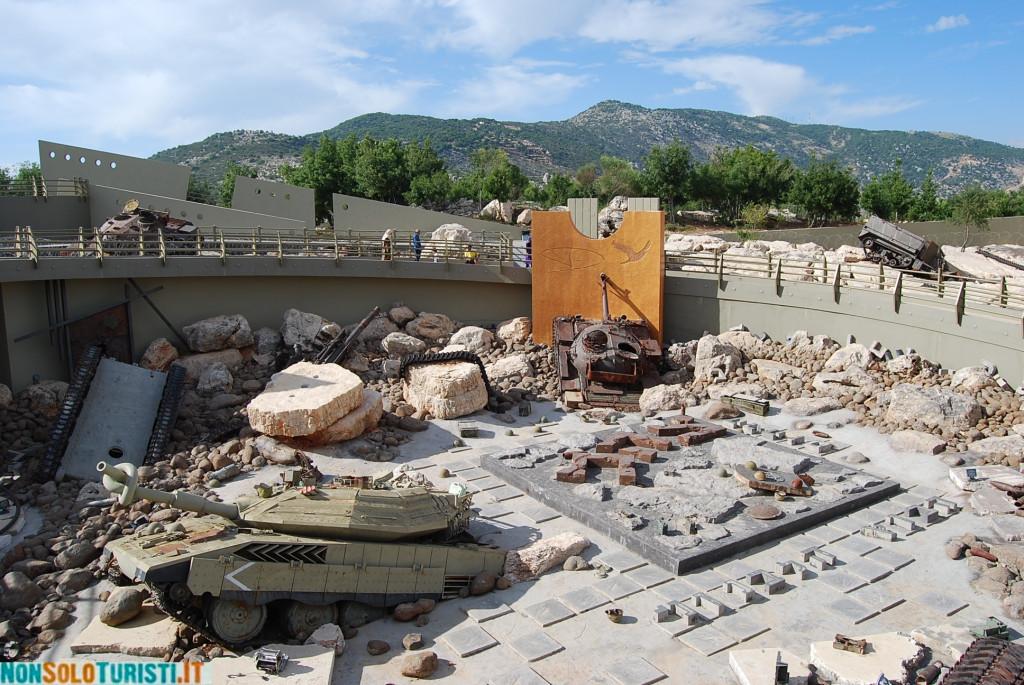When during our car trip in Southern Lebanon my travel companions suggested a visit to the Mleeta Resistance Tourist Landmark, the monumental museum established to honour Hezbollah’s fight against the Israeli occupation, I knew it would have been a fascinating experience. What I did not know was that Mleeta is not only a deeply historical monument, but also a well organized and satisfying museum.
Mleeta is a remote hill in the region called Nabatieh, about 70 kilometres from Beirut. We got there after countless turns, the road getting tighter and tighter, and after reaching several time for help from the friendly bystanders. Here, from 1985 to 2000, the Lebanese resistance fought the Israeli army applying guerilla and sabotage, facing the enemy’s impressive arsenal with bravery, sacrifice and faith. Today the hill is known as ‘the place where Earth talks to Paradise’.
After paying a cheap entrance fee the visitors are entitled to an experienced tour guide – a Hezbollah militant – who will lead them through the complex paths stretching through the site. In the central area an artistic reconstruction of a battlefield showcases ruins, armoured vehicles, artillery items and military equipment. Every fragment of that painful experience has been placed with great care to recall the violence of the battle, but also the achievement of a collective goal, long sought after and opposed to any probability.
In the multimedia hall a short video (available in Arab and English) works as an introduction of Hezbollah and the museum’s history. In the exhibition hall, instead, tens of military relics have been collected, and each one of them has a story to tell, a story of courage and heroism, a story of a small victory against the invaders. On the wall the Israeli leaders’ words express surprise and astonishment in front of defeat against a handful of soldiers whose only combat experiences where gathered in the guerrilla during the Palestinian war.
Behind the exhibition hall a path leads across the trenches. Several scenes of the frontline are scattered the dense vegetation, faithful representations of the lives of the thousands of mujahedeen who resisted here. There are automatic weapons, fortifications, even a shelter and an underground gallery.
Founded in 1982, Hezbollah – ‘God’s Party’ – was aimed to a comprehensive response, including a military, social and cultural point of view, to the invasion Israel started to annihilate the Palestinian resistance sheltered in Lebanon. Its main goal was liberation from the Israeli army, but its leaders also wanted to realize civil society according to the islamic principles.
In his book “Hizbollah – The Story from Within”, Sheikh Naim Qassem, party founder and vice-secretary since 1991, explains in the beginning a handful of spiritual leader wanted to offer guidance and relief to the exhausted population. After not a long time, the idea of Jihad became central in their project, with the double meaning of military defence of the islamic land and inner struggle towards spiritual rightfulness.
Defending the land obviously meant the liberation of Lebanon, but also the Palestinian occupation was a central point of Jihad. A strictly defensive aim, anyway, since the Prophet’s religion forbade any aggressive act against another country.
As for the establishment of an islamic country, it was understood in terms of political confrontation and collaboration: Hezbollah was officially giving up any violent mean to achieve such result which, in the words of Qassem, has to be fulfilled by politics and diplomacy.
‘We are not like the islamist groups fighting in Syria and Iraq – explained to us our guide – they gather the most desperate among the people promising Heaven after martyrdom. Our organization is made of educated people working together for a better society.’
The term martyrdom never fails to raise fear and horror in Western societies. And it’s true, without it Hezbollah could have never achieved the Israeli withdrawal in 2000, ending 22 years of occupation. But it has always been a last resort option, and its activity has never been limited to it.
Among hundreds of military operations, Hezbollah has also been involved in the reconstruction of Beirut and of the Lebanese villages which undergone the ruthless bombings, and in the relocation of homeless and refugees.
Israel and the United States accuse Hezbollah of being a terrorist group. And truly among its objective the party also included civil compounds in the occupied territories of Palestine. But its leader always stated that it was a response to the equally merciless killing of Lebanese civilians by Israel, and in any case an option only considered when military objectives were out of aim.
Even after Israel’s withdrawal, Hezbollah still has a very important role in Lebanon’s political scene and in maintaing safety and order in the South. Iran’s support and influence is clear, as the inference of Israel and US in the Lebanese government in order to dismantle the party. Nonetheless, today as in the past Hezbollah rises transcendental support among the population, beyond any religious and political barrier.
Useful information
Mleeta Resistance Tourist Landmark
The site opens every day from 9 am to sunset.The complete tour takes about 2-3 hours.The site is managed by the Lebanese Association for Tourism & Tradition, while Hezbollah militants offer themselves freely as guides and grants the visitors safety.
A degree in journalism and a professional limbo ranging from press offices to newspapers, magazines and finally the web. I lived in Verona, Zurich, London, Cape Town, Mumbai and Casablanca. I hate flying and I love jodel music. And when I grow up I wanna be a cosmonaut.



